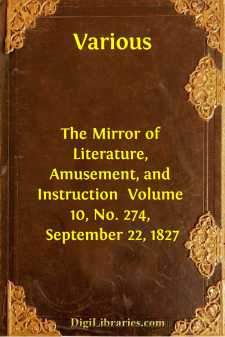Categories
- Antiques & Collectibles 13
- Architecture 36
- Art 48
- Bibles 22
- Biography & Autobiography 813
- Body, Mind & Spirit 142
- Business & Economics 28
- Children's Books 15
- Children's Fiction 12
- Computers 4
- Cooking 94
- Crafts & Hobbies 4
- Drama 346
- Education 46
- Family & Relationships 57
- Fiction 11828
- Games 19
- Gardening 17
- Health & Fitness 34
- History 1377
- House & Home 1
- Humor 147
- Juvenile Fiction 1873
- Juvenile Nonfiction 202
- Language Arts & Disciplines 88
- Law 16
- Literary Collections 686
- Literary Criticism 179
- Mathematics 13
- Medical 41
- Music 40
- Nature 179
- Non-Classifiable 1768
- Performing Arts 7
- Periodicals 1453
- Philosophy 64
- Photography 2
- Poetry 896
- Political Science 203
- Psychology 42
- Reference 154
- Religion 513
- Science 126
- Self-Help 84
- Social Science 81
- Sports & Recreation 34
- Study Aids 3
- Technology & Engineering 59
- Transportation 23
- Travel 463
- True Crime 29
The Mirror of Literature, Amusement, and Instruction Volume 10, No. 274, September 22, 1827
by: Various
Categories:
Description:
Excerpt
ARCHITECTURAL ILLUSTRATIONS.
THE TEMPLE CHURCH.
The Temple Church, London, was erected in the twelfth century; but among antiquarians considerable difference of opinion at various times prevailed as to who were the original builders of these round churches, which form the most striking and beautiful specimens of the architectural skill of our Anglo-Norman ancestors. In England there are four examples of round churches, almost in perfect preservation, namely, the church of St. Mary, Temple; St. Sepulchre, Northampton; St. Mary, Cambridge; and that of Little Maplestead, Essex. It was long thought that they were of Jewish origin; but through the ingenious and learned essays of Mr. Essex and of Mr. Britton, this erroneous notion has been entirely removed. Mr. Essex, in his Essay, observes, in support of his opinion, that "their Temple at Jerusalem was not of a circular form, neither was the Tabernacle of Moses; nor do we find the modern Jews affect that figure in building their synagogues. It has, however, been generally supposed that the round church at Cambridge, that at Northampton, and some others, were built for synagogues by the Jews while they were permitted to dwell in those places. But as no probable reason can be assigned for this supposition, and I think it is very certain that the Jews who were settled in Cambridge had their synagogue, and probably dwelled together in a part of the town now called the Jewry, so we may reasonably conclude the round churches we find in other parts of this kingdom were not built by the Jews for synagogues, whatever the places may be called in which they stand."—It has been generally allowed by these and other writers on archaeology, that the primitive church of this form was that of the Holy Sepulchre at Jerusalem, and that the Temple Church at London was built by the Knights' Templars, whose occupation was the protection of Christian pilgrims against the Saracens. It has been further urged by a correspondent (Charles Clarke, Esq. F.S.A.) in the first volume of Britton's "Architectural Antiquities," that two of the before-mentioned round churches, namely, Northampton and Cambridge, were in fact built by "affluent crusaders, in imitation of that of the Holy Sepulchre;" and in support of his opinion he cites several historical notices.
The late perfect restoration of the Temple Church ought to be proudly recorded in our architectural annals. The excellence of the workmanship, and the native purity of the detail, evince not only scientific skill, but also a laudable motive of preserving this antique specimen of pure Anglo-Norman architecture from the ravages of time. Let the architect's attention be directed to the western doorway, and also to the interior of the church; and here, in good preservation, he will see excellent specimens of their mode of ornamenting the moldings by the cable, the lozenge, the cheveron, the nail-head, the billet, &c. &c., ornaments peculiar to the round style. The circular-headed windows, with their slender columns, also show, that in the restoration the style has not been tampered with; but substantial authorities have been quoted to perfect this praiseworthy attempt of the architect....












